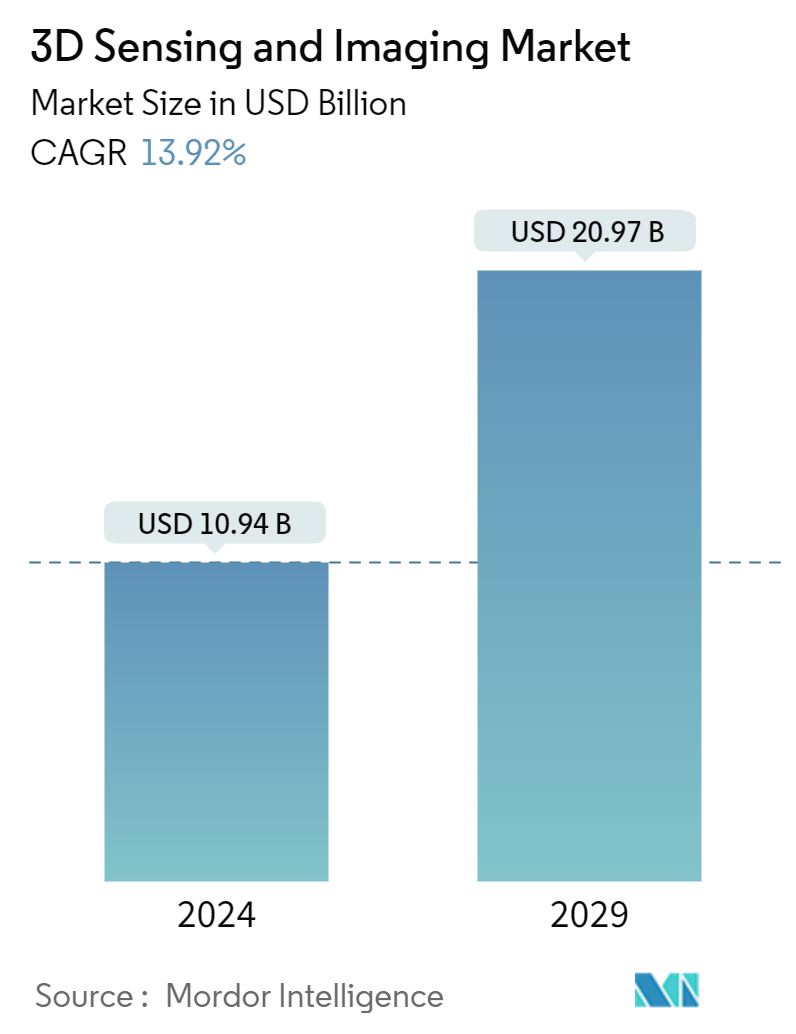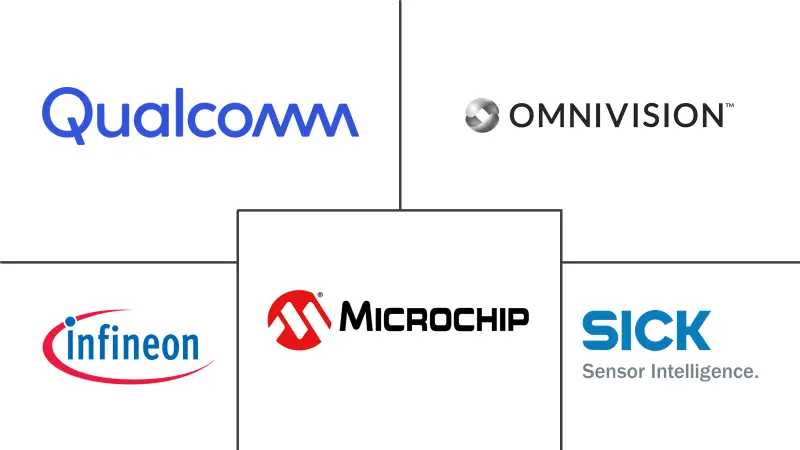Market Size of 3D Sensing And Imaging Industry

| Study Period | 2019 - 2029 |
| Market Size (2024) | USD 10.94 Billion |
| Market Size (2029) | USD 20.97 Billion |
| CAGR (2024 - 2029) | 13.92 % |
| Fastest Growing Market | Asia-Pacific |
| Largest Market | North America |
Major Players
*Disclaimer: Major Players sorted in no particular order |
3D Sensing and Imaging Market Analysis
The 3D Sensing And Imaging Market size is estimated at USD 10.94 billion in 2024, and is expected to reach USD 20.97 billion by 2029, growing at a CAGR of 13.92% during the forecast period (2024-2029).
- The increasing adoption of sensors in various industry verticals has led to the overall development of 3D technology that can measure shapes in real-time scenarios. The 3D sensing market is primarily driven by integrating 3D smartphone sensors for facial recognition and AR, enhancing security and user experience.
- The home gaming industry presented one of the first practical applications of 3D sensing technology for consumers, with time-of-flight (ToF) sensors that capture players' gestures and movements to build a new interactive gaming experience. However, 3D sensing is most noticeable in today's smartphone technology. User-facing 3D scanning increases security through facial recognition while world-facing 3D sensing establishes new opportunities for high-performance depth-sensing photography and augmented reality.
- In the healthcare sector, 3D sensing improves medical imaging and surgical precision. Additionally, industrial automation benefits from 3D sensors for quality control and robotics, while the gaming and entertainment industries use them for immersive AR and VR experiences. Technological advancements and decreasing costs are expected to further propel the market's growth opportunities significantly.
- Moreover, the growing application of image sensors in automobiles is considerably pushing the market's growth. Some of the key application areas of these automobile sensors involve dash cameras, advanced driver assistance systems (ADAS), LiDAR driver monitoring, and gesture recognition systems, among others. In the current market situation, the automotive industry features advanced driver-assistance systems (ADAS) and autonomous vehicles enabled by 5G and the IoT, making 3D sensing a vital part of transportation safety. The LiDAR systems also provide short- and long-range 3D sensing that allows vehicles to assess their surroundings in real-time scenarios independently.
- The major market players in the industry are focusing on introducing new products. For instance, in April 2024, Quanergy Solutions Inc., a provider of 3D LiDAR technology for physical security and business intelligence applications, launched two new additions to its portfolio of 3D LiDAR solutions. The new Q-Track HD and Q-Track Dome 3D LiDAR sensors join Quanergy's Q-Track LR (Long Range) offering to comprise the industry's most comprehensive portfolio of high-performance 3D LiDAR solutions. Quanergy 3D LiDAR detection, classification, and tracking technology provides 20X the accuracy of legacy technologies at less than half the cost.
- However, factors like the high manufacturing cost of image sensors, limited integration options with other devices, and the involvement of high costs required to maintain these devices are some factors that can restrain the market's growth opportunities during the forecast period.
- The 3D sensing market for industrial and consumer applications was negatively affected during the COVID-19 period due to the decline in consumer spending trends that led to the macro slowdown of the economy across the world. However, during the post-COVID-19 environment, the increasing adoption of 3D sensing and imaging technology, especially in smartphones, gaming consoles, and the automotive industry, is expected to increase the demand for 3D sensing technology applications.
3D Sensing and Imaging Industry Segmentation
3D sensing is a depth-sensing technology that augments camera capabilities for object and facial recognition in augmented reality, autonomous driving, gaming, and a wide range of other applications. It involves capturing a real-world object's length, width, and height with greater clarity and in-depth detail, which can be achieved using various technologies such as structured light and time of flight.
The 3D sensing market is segmented by component (hardware, software, and services), technology (ultrasound, structured light, time of flight, stereoscopic vision, and other technologies), type (position sensor, image sensor, temperature sensor, accelerometer sensor, proximity sensor, and other types), connectivity (wired network connectivity and wireless network connectivity), end-user industry (consumer electronics, automotive, healthcare, aerospace and defense, security and surveillance, media and entertainment, and other end-user industries), and geography (North America, Europe, Asia-Pacific, Latin America, and Middle East and Africa). The report offers the market size and forecasts for all the above segments in value (USD).
| By Component | |
| Hardware | |
| Software | |
| Services |
| By Technology | |
| Ultrasound | |
| Structured Light | |
| Time of Flight | |
| Stereoscopic Vision | |
| Other Technologies |
| By Type | |
| Position Sensor | |
| Image Sensor | |
| Temperature Sensor | |
| Accelerometer Sensor | |
| Proximity Sensor | |
| Other Types |
| By Connectivity | |
| Wired Network Connectivity | |
| Wireless Network Connectivity |
| By End-user Industry | |
| Consumer Electronics | |
| Automotive | |
| Healthcare | |
| Aerospace and Defense | |
| Security and Surveillance | |
| Media and Entertainment | |
| Other End-user Industries |
| By Geography*** | |
| North America | |
| Europe | |
| Asia-Pacific | |
| Middle East and Africa | |
| Latin America |
3D Sensing And Imaging Market Size Summary
The 3D sensing and imaging market is poised for significant growth, driven by the increasing adoption of sensors across various industry verticals. This technology, which allows for real-time shape gauging, has evolved from bulky instruments to more compact solutions due to advancements in technology. Initially popularized in the home gaming industry through interactive experiences using time of flight sensors, 3D sensing has found its most prominent application in smartphones. Here, it enhances security with facial recognition and opens new avenues in depth-sensing photography and augmented reality. The automotive sector, once an unlikely beneficiary, now integrates 3D sensing in advanced driver-assistance systems and autonomous vehicles, underscoring its importance in transportation safety. Technologies like LiDAR are crucial for creating detailed environmental maps, enhancing vehicle navigation and obstacle detection.
The market's expansion is further supported by technological advancements such as time of flight, structured light, and stereoscopic vision, which are increasingly adopted across industries. Despite the challenges posed by the COVID-19 pandemic, which temporarily slowed consumer and industrial applications, the demand for 3D sensing technology in smartphones and gaming consoles is expected to drive market growth. North America, particularly the United States, is anticipated to hold a significant market share, fueled by high demand in consumer electronics and automotive sectors, along with substantial investments in IoT. The competitive landscape is marked by continuous innovations, with companies like STMicroelectronics and LIPS Corporation launching advanced 3D sensing products to strengthen their market positions. These developments highlight the dynamic nature of the market, as players strive to secure new contracts and expand their presence in emerging markets.
3D Sensing And Imaging Market Size - Table of Contents
-
1. MARKET INSIGHTS
-
1.1 Market Overview
-
1.2 Industry Attractiveness - Porter's Five Forces Analysis
-
1.2.1 Bargaining Power of Suppliers
-
1.2.2 Bargaining Power of Consumers
-
1.2.3 Threat of New Entrants
-
1.2.4 Threat of Substitutes
-
1.2.5 Intensity of Competitive Rivalry
-
-
1.3 Industry Value Chain Analysis
-
1.4 Impact of the Aftereffects of the COVID-19 Pandemic and Other Macroeconomic Factors on the Market
-
-
2. MARKET SEGMENTATION
-
2.1 By Component
-
2.1.1 Hardware
-
2.1.2 Software
-
2.1.3 Services
-
-
2.2 By Technology
-
2.2.1 Ultrasound
-
2.2.2 Structured Light
-
2.2.3 Time of Flight
-
2.2.4 Stereoscopic Vision
-
2.2.5 Other Technologies
-
-
2.3 By Type
-
2.3.1 Position Sensor
-
2.3.2 Image Sensor
-
2.3.3 Temperature Sensor
-
2.3.4 Accelerometer Sensor
-
2.3.5 Proximity Sensor
-
2.3.6 Other Types
-
-
2.4 By Connectivity
-
2.4.1 Wired Network Connectivity
-
2.4.2 Wireless Network Connectivity
-
-
2.5 By End-user Industry
-
2.5.1 Consumer Electronics
-
2.5.2 Automotive
-
2.5.3 Healthcare
-
2.5.4 Aerospace and Defense
-
2.5.5 Security and Surveillance
-
2.5.6 Media and Entertainment
-
2.5.7 Other End-user Industries
-
-
2.6 By Geography***
-
2.6.1 North America
-
2.6.2 Europe
-
2.6.3 Asia-Pacific
-
2.6.4 Middle East and Africa
-
2.6.5 Latin America
-
-
3D Sensing And Imaging Market Size FAQs
How big is the 3D Sensing And Imaging Market?
The 3D Sensing And Imaging Market size is expected to reach USD 10.94 billion in 2024 and grow at a CAGR of 13.92% to reach USD 20.97 billion by 2029.
What is the current 3D Sensing And Imaging Market size?
In 2024, the 3D Sensing And Imaging Market size is expected to reach USD 10.94 billion.

